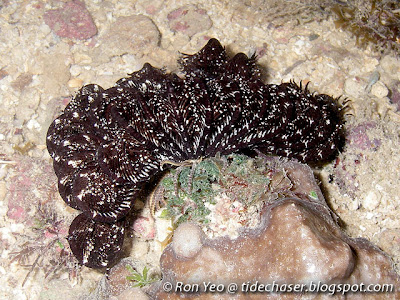Feathers stars or crinoids (class Crinoidea) are marine animals with five or more feather-like arms. Each arm carries comb-like structures called pinnules, comprising rows of tube feet used for capturing plankton. On the underside, most feather stars have claw-like arms called cirri to hold on to the substrate. Their skeleton is made of numerous calcareous plates.

Feather stars belong to a bigger group of animals called the spiny-skinned animals (phylum Echinodermata - "echino" roughly means "spiny"; "derma" roughly means "skin"). Examples of other echinoderms include sea stars, sea cucumbers, and sea urchins.
Like other echinoderms, feather stars have a five-part body plan with radial symmetry (i.e. pentaradial symmetry), at least in some stage of life. In other words, you can divide a feather star into 5 equal parts. Also, they are able to regenerate lost body parts - such as an arm bitten off by a predator. Echinoderms are brainless, but despite that, they can still perform their daily functions - they can move, they can eat, they can shit, and they can reproduce - all these without a brain! Also, instead of blood vessels, echinoderms have a water vascular system. This system is essentially a network of water-filled vessels used for internal transportation of oxygen, food and waste. By adjusting the water pressure, the feather star is able extend and retract its arms for feeding. They can even swim by flapping their arms.
Many feather stars feed in the night hide in crevices in the day, though a number of them can be seen in the day too. 18 species of crinoids have been recorded from Singapore waters, but they are just too difficult to identify for the lay person.
Here are some feather stars that I have photographed, mostly unidentified.

Red feather star (Himerometra sp.).

Comatula purpurea?




Stephanometra sp.?

Stephanometra sp.?

Stephanometra sp.?









Like most other marine organisms, the crinoids in Singapore are threatened by loss of habitats and collection.
References

Feather stars belong to a bigger group of animals called the spiny-skinned animals (phylum Echinodermata - "echino" roughly means "spiny"; "derma" roughly means "skin"). Examples of other echinoderms include sea stars, sea cucumbers, and sea urchins.
Like other echinoderms, feather stars have a five-part body plan with radial symmetry (i.e. pentaradial symmetry), at least in some stage of life. In other words, you can divide a feather star into 5 equal parts. Also, they are able to regenerate lost body parts - such as an arm bitten off by a predator. Echinoderms are brainless, but despite that, they can still perform their daily functions - they can move, they can eat, they can shit, and they can reproduce - all these without a brain! Also, instead of blood vessels, echinoderms have a water vascular system. This system is essentially a network of water-filled vessels used for internal transportation of oxygen, food and waste. By adjusting the water pressure, the feather star is able extend and retract its arms for feeding. They can even swim by flapping their arms.
Many feather stars feed in the night hide in crevices in the day, though a number of them can be seen in the day too. 18 species of crinoids have been recorded from Singapore waters, but they are just too difficult to identify for the lay person.
Here are some feather stars that I have photographed, mostly unidentified.

Red feather star (Himerometra sp.).

Comatula purpurea?




Stephanometra sp.?

Stephanometra sp.?

Stephanometra sp.?









Like most other marine organisms, the crinoids in Singapore are threatened by loss of habitats and collection.
References
- Castro, P & M. E. Huber, 2003. Marine biology. McGraw-Hill, US.
- Lane, D. J.W. & D. Vandenspiegel, 2003. A Guide to sea stars and other echinoderms of Singapore. Singapore Science Centre.
- Lane, D.J.W., L.M. Marsh, D.VandenSpiegel, & F.W.E. Rowe. 2000. Echinoderm fauna of the South China Sea: an inventory and analysis of distribution patterns. The Raffles Bulletin of Zoology, Suppl.8: 459-493.
- Liao, Y. & A. M. Clark, 1995. The Echinoderms of Southern China. Science Press, China.

No comments:
Post a Comment